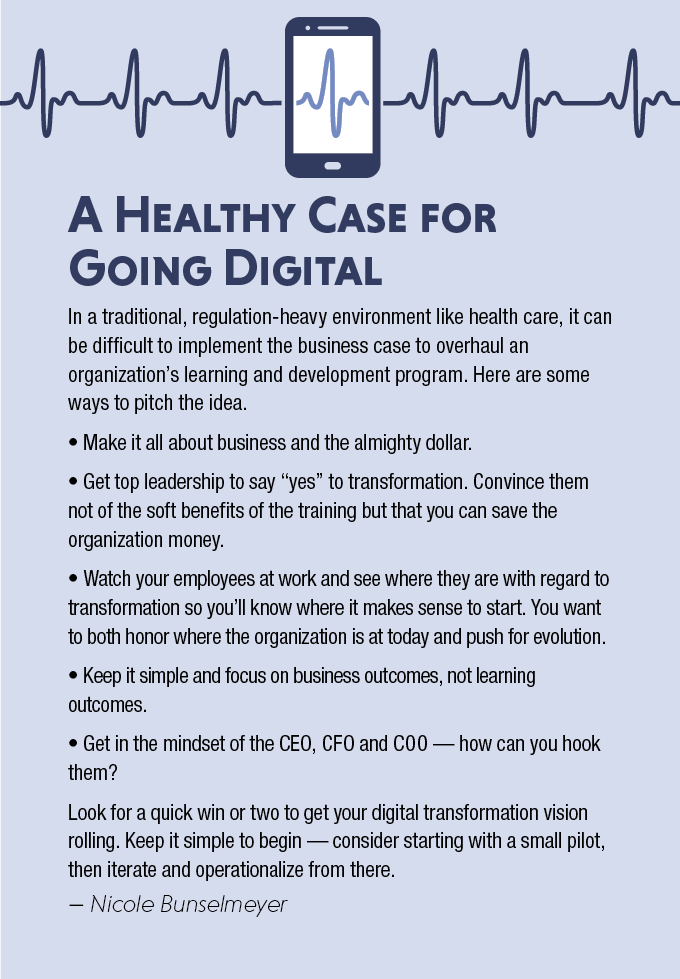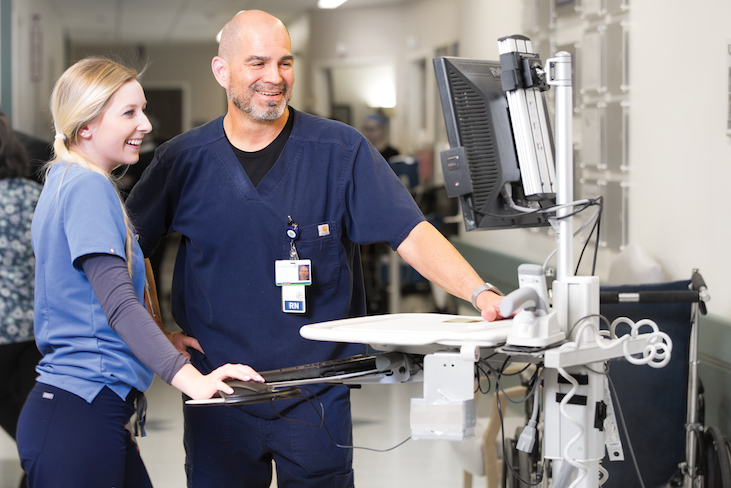Health care’s foundational employee training lies in old-school brick-and-mortar academics, but the challenges facing the industry — including large technology rollouts, staff attraction and retention, compliance training and the influx of millennials to the health care workforce — mean learning and development departments have to figure out how to go digital to accommodate employees and the patients they serve.
This requires health care L&D departments to build out their learning technology suites carefully and find the delicate balance between employee needs and what the organization expects in order to serve patients and the community.
“It’s a definite challenge for us,” said Darci Hall, interim chief learning officer of multistate health care provider Providence St. Joseph Health. “We must figure out how to baby-step our older generation of learners, who are accustomed to ILT and only ILT, into possibly doing things in a digital space. So we say, OK, we’ll do an in-person event for, say, leadership training, but then you’re going to have virtual sessions that support it throughout the year.”
A blended learning strategy can be a great first way for those in the tradition-mired health care industry to implement a digital approach while respecting the needs of their older employees and younger learners, as well as the needs of the organization.
“We want to mirror the way our caregivers consume [learning] outside of Providence, but in the type of environment we have, there are challenges in the transition to digital,” said Hall, whose employee base numbers more than 100,000 in seven Western states. “It’s critical, however, so we’re making it happen.”
One of the many reasons the shift to digital learning is so important is the ever-present cost maintenance that all L&D departments face, not just in health care. Utilizing learning technologies can help. This is an area in which health care has traditionally progressed slowly, but looking to corporate models to bring digital learning closer to everyday work more quickly can be a great way to move a learning vision forward for a health care organization.
Applying an Electronic Health Records System
One large health care organization was faced with training more than 50,000 employees on a new electronic health record system — the largest such project in the organization’s history. The training team was faced with reducing the amount of time staff spent in the classroom. This would allow employees to continue providing routine care to patients without seeing a negative impact on staffing availability or revenue.
The organization had the additional challenge of encompassing a large spectrum of roles, responsibilities and geographic lo-cations in addition to generational differences. Because of the size and scope of the project, it was deemed a significant change-management initiative, not just a technology-adoption project.
The learning team challenged itself to think differently and created a vision to focus on developing and delivering learning to support the transfer of knowledge, promote engagement, reinforce what is taught and create a dynamic, rapid learning environment.
One overarching goal was to develop an understanding of learners’ needs and create a role-specific workflow with continuous support post-implementation.
The program included role-based pathways and was delivered as blended learning to include classroom-led instructor training, competency assessment in the learning management system and an online MOOC environment. Electronic content was internally created and branded to support the role-based learning, including videos, interactive learning methods and quizzes. Bite-size content was also incorporated. Learner engagement was monitored daily as they attended instructor training; upon completion, access was granted to the live software environment.
Results are still being evaluated, but the program reached all its intended recipients in a tight timeframe with positive learner feedback. The health care organization’s L&D department determined that the shift to digital opportunities, which accommodate varied learning challenges facing the organization, was a fundamental part of the solution.
The Tech Suite for Learning
Providence’s Hall said there is no single solution that will make health care’s L&D transformation happen overnight. It will require a mix of technologies that tackle different problems, put together in a logical fashion.
“We’re going through right now the process of modernization and getting an inventory of what we have,” said Hall, whose digital learning program won four Brandon Hall Excellence awards in 2018. “Content, tools, LMSs, all of that stuff, and starting to figure out what kinds of technologies we need to support our future state vision of learning.”
Those technologies can include collaborative learning, cohort-driven learning, time-sensitive online learning, adaptive learning, spatial learning and more. “We’re experimenting with how we can do one-minute learnings over a longer period of time rather than one four-hour training chunk in order to lead to adoption and habits that we want our caregivers to form, especially around the regulatory and compliance space,” Hall said.
That is another challenge facing health care training leaders: how to reduce the required and mandatory learning hours its health care employees have to spend on training, when those “mandatory” hours actually contain optional information. Also, organizations such as Providence, which are spread across multiple states, are looking to standardize training to ensure high-performing, consistent learning.
“With that reduction, we’re also looking to implement learning that is more performance-based and integrated into their work,” Hall said. One way is to utilize adaptive learning and have employees assessed and test out of certain sections they are already fluent with in order to reduce the time they are spending on training.
If people are prompted with questions that result in different pathways, a 10-minute e-learning module could wind up being only two minutes for someone who really knows the content and who can answer the appropriate questions correctly. “This is really important to the health care space, as we’re required to provide hundreds of hours of required learning, and some of it is redundant to some employees,” Hall said.
Boosting Nurse Leadership Training
Employees are engaged when they have better leadership. Providence St. Joseph Health was facing high turnover and difficulty attracting talent in 2017. More specifically, it needed to train nurse managers in a way that would be easily applicable on the job without taking them away from work for too long. Their solution: a blended learning experience that is changing the culture of learning at Providence St. Joseph.
 The program targeted the approximately 930 nurse managers working within the health care provider’s system. The goal was to enhance the leadership skills of the nurse manager population to prepare them for higher-level roles. Providence St. Joseph aimed to promote the nurse manager role as a professional specialty, reduce the amount of turnover among caregivers and nurse managers, and improve caregiver engagement.
The program targeted the approximately 930 nurse managers working within the health care provider’s system. The goal was to enhance the leadership skills of the nurse manager population to prepare them for higher-level roles. Providence St. Joseph aimed to promote the nurse manager role as a professional specialty, reduce the amount of turnover among caregivers and nurse managers, and improve caregiver engagement.
It was imperative that nurse managers viewed the program as both valuable and relevant to their practice. The only way to achieve this was through close collaboration with nursing leaders, whose involvement was critical to the program’s success. Additionally, the delivery had to be flexible enough to meet the needs of the busy nurse managers.
The program was designed as a five-month leadership development learning curriculum. The blended learning approach focused on enhancing leadership skills such as communication, goal setting, managing teams, coaching, resolving conflicts and leading change initiatives. It also covered self-care, financial acumen, development planning and recognizing unconscious bias. A pilot version was delivered from May through October 2017, and feedback from pilot participants, faculty and nursing leadership was used to inform the design of the scaled version.
The pilot consisted of a five-month learning journey that wrapped an online experience around four in-person sessions. Over the course of the experience, nurse managers had opportunities to practice and reflect on critical leadership topics like uncon-scious bias, goal setting, coaching and conflict resolution. Nurse managers participated as part of a smaller cohort to connect and collaborate with colleagues in other hospitals. In addition to the peer support, nurse managers had check-ins with their managers.
The four in-person events were wrapped with online content, peer discussions and missions that applied learning to the real job. Smaller peer groups were formed at the in-person events to foster networking and continued through online discussion forums.
Providence St. Joseph Health used a multiphased assessment approach to track the ROI and impact of the program. This in-cluded evaluations to determine the immediate reaction to the program, pre- and post-surveys to assess the response to the learning, follow-up surveys to track growth, data to track turnover rates, and patient experience surveys to gauge the changes in the organization.
The results of the pilot were positive. Nurse managers gave the overall quality of in-person sessions a score of 4.75 out of 5. They rated the direct application of content to the job at 4.85, and when asked how strongly participants would recommend the content to other nurse managers, the result was 4.95 out of 5. Nurse managers’ comfort level with using leadership skills before the program averaged 2.75. After completing the program, this rose 1.15 points to an impressive 3.9 out of 5.
Their overall knowledge of the covered topics rose, too. The nurse managers’ improvement in knowledge acquisition rose from a 2.75 average before the program to 4.25 after completion.
Inspiration Outside Health Care
There are other industries health care L&D leaders can look to for potential learning solutions, including retail. One large retailer set up a certification program that allows its stockers who want to become cashiers, or cashiers who want to become managers, to take courses at a kiosk in the store on their own time to achieve certification. When a slot opens up for promotion, they’re already certified.
Health care can use the same model for medical assistants who either want to progress to more senior medical assistant roles or move into nursing or nutrition. While they still need formal training, such as through a community college or vocational pro-gram, increased accessibility to learning and clear learning paths are a great way to increase retention and make the career journey distinct.
“Retail is a big one,” Hall said. “But we also look to professional services like the EYs and KPMGs of the world because of the compliance and regulatory limits those types of firms have to abide by with their licensure regulatory and compliance issues. But really any industry with a distributed environment can be a good corporate model for us in health care.”
Learner experience in digital wins over everything else, Hall said. “Moving the dial even just a little bit is huge for our caregivers. Just a little difference is highly impactful, and we can measure it, then iterate and operationalize moving forward.”
Health care organizations looking to move to a new state of readiness, retention and attraction with their learning, who want to create a daily habit of learning for their staff and move the organization forward, can look to digital steps to enact learning visions for the future that will help control costs, enact change management for the organization and satisfy learners.















